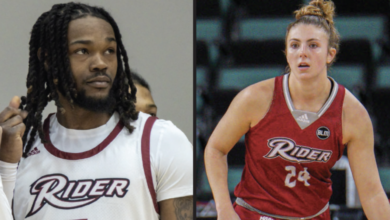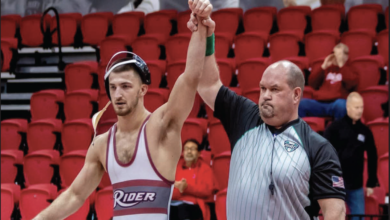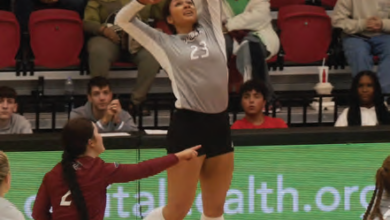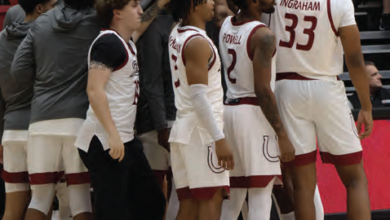
‘The shot’: Much more than four seconds
By Shaun Chornobroff
Rider Hall of Fame men’s basketball coach Kevin Bannon was pacing the sidelines in utter disbelief.
The announcer says, “He can’t believe there was a foul.”
With the 1993 Northeast Conference (NEC) Championship on the line, Rider was barely holding onto a lead against Wagner College and had put the Seahawks leading scorer, Bobby Hopson, on the line with 11 seconds to go.
Hopson sank the first free throw to trim Rider’s lead to 63-62.
The announcer then said, “He hasn’t hit the rim in his last three foul shots.”
He must have been a jinx.
Hopson clanked the game tying free throw off of the rim, but to his relief, Wagner’s Quincly Lewis came up with the rebound and fed their leading scorer once again.
Hopson drove in from the left side and right before meeting a Rider defender, let a floater into the air, this time putting the ball into the basket for his 32nd point of the night, as multiple Rider players and a packed alumni gym could do nothing but potentially watch their team’s dreams of playing in the NCAA tournament go to the wayside.
What happened next is a moment in history that was displayed in front of a national audience on ESPN and has been published on YouTube as “The Shot: Four Seconds From Glory.”
Wagner was four seconds from glory. For Rider, it was four seconds until glory.
The score now had the Broncs trailing 64-63 and inbounding the ball from under its own basket.
They had to go the entire length of the court in four seconds to win this game. And everybody knew the ball was going to NEC Player of the Year and Rider’s superstar senior guard Darrick Suber.
But that was not the plan. Suber explained in a 2003 article published by ESPN that he was supposed to be used as a decoy in the original play design.
Suber was not fond of the idea of being used as a decoy in the biggest and possibly final play of his collegiate career.
The senior leader and program’s all-time leading scorer turned to sophomore Chris Mikola and with extreme confidence said, “Get me the ball and we’ll win.”
It proved to be fairly easy to get Suber the ball.
Wagner came out in a half court defense, meaning that with four seconds left and with Suber standing around 15 feet from half-court, there was no one to stop Rider’s best player from receiving the ball.
Suber, who had 31 of Rider’s 63 points in the game, received an inbounds pass with ease and made his way past the first Wagner defender, Bobby Hopson.
Wagner Head Coach Tim Capstraw did the only thing any coach could do at this point: hope.
“I was saying ‘Oh my God! They are going to get a shot, just make sure it’s off balance and a tough shot. That’s all you can ask for,’” Capstraw said after the game.
Capstraw got his wish.
After gliding past the first defender, Suber drove inside the three-point line, then on the stroke of death, he maneuvered the ball away from a significantly taller Wagner defender, simultaneously creating enough separation from the other three players closing in on him, to fulfill Capstraw’s wishes and release an off balance, contested shot, similar, but significantly more difficult to the one Hopson had released moments before.
Swish.
The buzzer sounded, four seconds elapsed and Rider had emerged victorious. Suber scored his 33 and final point of the night, barely enough to propel Rider to a 65-64 victory, sending the team to the NCAA tournament.
“He did his thing. While he was doing his thing, I was saying to myself ‘We won the game.’ I knew it,” Mikola said after Suber’s game winner.
“This is something I will remember for the rest of my life,” Suber said after sending Rider to the NCAA Tournament. “I have never been in this situation before.”
“It was a great shot, but it was a great reaction,” said Don Harnum, an assistant coach of the team. “Our gym’s not very big. We had no chance to keep people off the court. From the immediate court storm, to the euphoria in there, to the announcer screaming ‘we’re going to the big show.’”
Harnum now serves as Rider’s Athletic Director. He first came to the school in 1989 and was a part of the turnaround that culminated in that moment from the beginning.
“We made a commitment four years ago to try and build our program,” Bannon said after winning his first of two NEC tournament titles. “In 11 years as a head coach, I’ve never had a team that has grown so much in so many different ways throughout a season. A lot of kids have improved as players.”
“All year long it just got better and better,” Bannon said. “We were 1-5, and we lost William Kinsel for the season. I have never had a group that just addressed what they had to do to be good, and they did. It’s just a great feeling.”
Rider looked down and out six games into the 1992-93 season after a double-digit loss against Niagara University that sunk the team to 1-5.
Combine that with the loss of Kinsel, a senior leader, who was returning after an impressive junior season where he averaged 9.4 points and 7.2 rebounds per game, Rider seemed to be in for a disappointing season. But the Broncs rebounded and went 18-5 in their final 23 games to take their conference tournament.
The challenges that Bannon had to overcome in rebuilding Rider as a program might be the greatest adversity that this game represented.
Bannon took over a program in dire straits. Rider had not seen a team finish with a winning record in half a decade and there did not seem to be much hope on the roster that things would change anytime soon.
Before Bannon took over as head coach, Rider was a consistent bottom feeder that had won just 15 games in its previous two seasons. Bannon immediately gave some reason for hope, as the Broncs won 10 games and got significant contributions from Suber, who led the team in scoring as a freshman.
The ensuing three years Bannon and Suber saw the program grow together. Suber’s game winner, which has become known as “The Shot,” was the pinnacle of a monumental rebuild.
“People always talk about ‘The Shot’ but it was so much more than that,” Suber said to NJ.com in 2014.
“It was about building a program, starting where we were and getting to where we got. It wasn’t just about those four seconds.”
“Coach Bannon’s first year was my first year,” Suber said in 2010. “He was taking over a program that was near the bottom of Division I basketball, and now, after three-plus years of hard work, we had earned the chance to host the NEC Championship game on our floor.”
On their home floor that had a closer resemblance to a modern day high school gymnasium, then the home court that the men’s basketball team plays on today, Suber put his beloved head coach, the entire men’s basketball team and a 1,600 person, sold out crowd on his back and within four seconds and one shot, made a dream that only three years before seemed impossible to become a reality.



